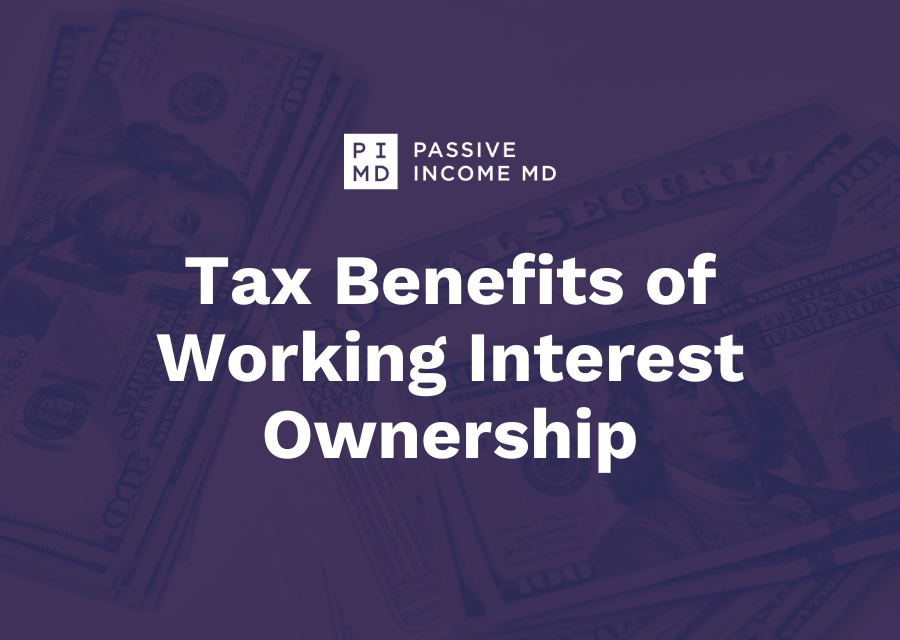This post is brought to you in partnership with Eckard Enterprises. We’re always looking to share valuable insights with our community, and while this is a sponsored post, we only feature content that we believe will be helpful and relevant to our readers. The views and opinions expressed are those of Eckard Enterprises.
Let’s be honest… when you first hear about the tax benefits of oil and gas working interests, it sounds like a secret menu item for high-income earners.
“Wait, you’re telling me there’s a way to reduce taxes while generating income?”
Yes… but also, slow down.
If you’re a physician looking to create more tax-efficient income streams, this might catch your eye. But before you go chasing drilling rigs in Texas, know this: working interest ownership isn’t exactly passive. Yes, it comes with bigger potential benefits, but also more hands-on involvement and risk compared to things like mineral rights.
So in classic “no fluff” fashion, let’s break this down. I’ll walk you through the core tax benefits (minus the hype), where this kind of investment might fit in your plan, and what questions to ask before getting too excited.
As always, this is educational. Talk to your CPA or tax pro before jumping in.
Working Interest vs. Mineral Rights
- Mineral rights (royalties): You own the subsurface rights, lease them to an operator, and receive royalty income with little ongoing involvement.
- Working interest: You own a percentage of the actual drilling/production project, sharing in costs and revenues. This route involves higher risk and responsibility, but it’s also where the material tax benefits typically show up.
The Core Tax Mechanisms
When you invest in a working interest, the tax code treats certain costs differently than it would in a typical investment, and that’s where much of the appeal comes from.
Two main concepts are worth understanding: intangible drilling costs (IDCs) and depletion.
Intangible Drilling Costs (IDCs)
These are the expenses that go into drilling a well but can’t be resold later. Things like labor, site preparation, and supplies that are used up in the process. Because they have no lasting value on their own, the IRS allows investors to deduct most of these costs either all at once in the first year or spread out over several years.
In many projects, IDCs make up 60–80% of the total drilling bill, so the potential tax deduction can be significant if you have taxable income to offset.
Depletion
Once a well starts producing, you may also qualify for what’s called a depletion deduction. Think of it like depreciation on real estate: as the oil or gas is pulled out of the ground, the tax code lets you account for that natural decline in value by reducing the taxable income tied to production.
Not every investor qualifies for depletion in the same way, and the rules can be complex, so this is an area where your CPA’s guidance is especially important.
Together, IDCs and depletion form the backbone of the tax advantages in working interest ownership. One helps front-load deductions when a project begins, and the other can soften the tax bill over time as production occurs.
How These Benefits Show Up in Practice
Timing: IDC deductions are often front-loaded, meaning potential tax relief can occur before full production ramps up the ability to deduct in the first year (or amortize over 60 months) can help offset current-year income, subject to elections and your facts.
Magnitude: Because IDCs can be a major share of total drilling spend (the reference cites 60–80%), the deduction potential isn’t trivial. That said, the actual percentage varies by project, and deductions only matter if you have taxable income to offset (and if the elections are properly executed).
Production phase: As (and if) wells produce, depletion may further reduce taxable income tied to extracted volumes, according to the references. Applicability and method should be modeled with your tax advisor.
How Physicians Can Frame the Decision
For many physicians, the easiest way to understand working interest ownership is to contrast it with mineral rights.
Mineral rights function more like owning a rental property without tenants; you collect royalty checks with little direct involvement, but also fewer upfront tax deductions. Working interest, on the other hand, is closer to becoming a co-owner in the “building” of the project itself: you share in both the costs and the results, and the tax benefits can be substantial if structured well.
Before moving forward, it helps to bring targeted questions to your CPA so you can ground the decision in your own circumstances.
For example, you might ask:
- Given my income and goals, should I deduct intangible drilling costs immediately or spread them over several years?
- Based on how this project is structured, does depletion apply to my share of production, and how would that affect my returns?
- What kind of record-keeping and documentation will I need from the operator to make sure these deductions hold up at tax time?
By framing working interest in this way, more hands-on than mineral rights, with greater variability but also meaningful tax leverage, you can better decide if it fits your portfolio and your risk tolerance.
WANT TO LEARN MORE ABOUT OIL, GAS, AND MINERAL RIGHTS INVESTING? SUBSCRIBE AND LISTEN TO PIMD PODCAST EPISODE #228 The Truth About Mineral Rights Investments ft. Troy Eckard of Eckard Enterprises

Subscribe to receive the 7 Steps you can follow to achieve Financial Freedom
If financial freedom is your goal, there’s no better time to get started than right now.
Unlock actionable steps that you can take every day to fine-tune your goals, discover your interests, and avoid costly mistakes on your financial freedom journey.
Bottom Line
At the end of the day, working interest ownership can be a pretty powerful tool in your tax toolbox, thanks to things like intangible drilling cost deductions and potential depletion benefits. But don’t forget, this isn’t set-it-and-forget-it investing. It comes with higher risk, shared costs, and a learning curve.
So if you’re a physician trying to level up your tax efficiency, just remember: education first, conservative modeling second, and smart partnerships always. The tax tail should never wag the investment dog.
If the idea of owning real, tangible assets in the U.S. energy space has you curious (and it should), take a look at what Eckard Enterprises is doing. They’re a family-owned firm with deep expertise in mineral rights and energy investments, and they’ve helped a lot of physicians like you navigate this space with confidence.
You can learn more at eckardenterprises.com or just reach out to ask questions. No pressure, just information.
Because when it comes to building wealth and reducing taxes, the right opportunities (and the right partners) can make all the difference.
Stay curious, stay intentional, and don’t be afraid to ask questions. The more you understand what you’re getting into, the better decisions you’ll make.
If you’re interested in more, subscribe to our newsletter for more content that will help you in and out of medicine. As always, make it happen!
Peter Kim, MD is the founder of Passive Income MD, the creator of Passive Real Estate Academy, and offers weekly education through his Monday podcast, the Passive Income MD Podcast. Join our community at the Passive Income Doc Facebook Group.
Further Reading



